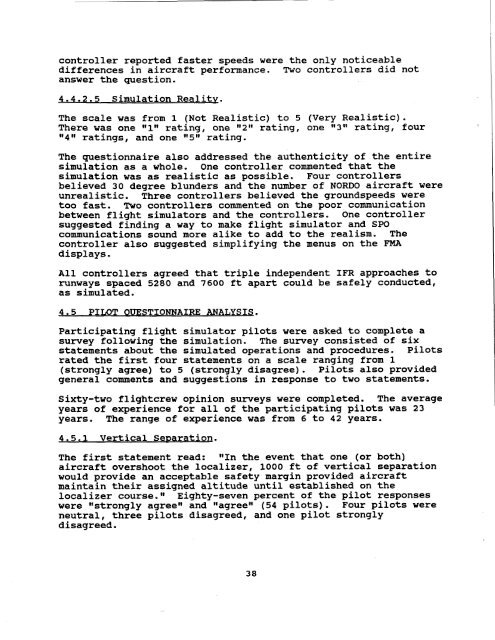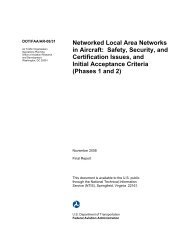Published Report (DOT/FAA/CT-94-36)
Published Report (DOT/FAA/CT-94-36)
Published Report (DOT/FAA/CT-94-36)
You also want an ePaper? Increase the reach of your titles
YUMPU automatically turns print PDFs into web optimized ePapers that Google loves.
controller reported faster speeds were the only noticeable<br />
differences in aircraft performance. Two controllers did not<br />
answer the question.<br />
4.4.2.5 Simulation Reality.<br />
The scale was from 1 (Not Realistic) to 5 (Very Realistic).<br />
There was one lrlll rating, one 1121f rating, one fr311 rating, four<br />
1f411 ratings, and one 115f1 rating.<br />
The questionnaire also addressed the authenticity of the entire<br />
simulation as a whole. One controller commented that the<br />
simulation was as realistic as possible. Four controllers<br />
believed 30 degree blunders and the number of NORDO aircraft were<br />
unrealistic. Three controllers believed the groundspeeds were<br />
too fast. Two controllers commented on the poor communication<br />
between flight simulators and the contrcllers. One controller<br />
suggested finding a way to make flight simulator and SPO<br />
communications sound more alike to add to the realism. The<br />
controller also suggested simplifying the menus on the FMA<br />
displays.<br />
All controllers agreed that triple independent IFR approaches to<br />
runways spaced 5280 and 7600 ft apart could be safely conducted,<br />
as simulated.<br />
4.5 PILOT OUESTIONNAIRE ANALYSIS.<br />
Participating flight simulator pilots were asked to complete a<br />
survey following the simulation. The survey consisted of six<br />
statements about the simulated operations and procedures. Pilots<br />
rated the first four statements on a scale ranging from 1<br />
(strongly agree) to 5 (strongly disagree). Pilots also provided<br />
general comments and suggestions in response to two statements.<br />
Sixty-two flightcrew opinion surveys were completed. The average<br />
years of experience for all of the participating pilots was 23<br />
years. The range of experience was from 6 to 42 years.<br />
4.5.1 Vertical SeDaration.<br />
The first statement read: "In the event that one (or both)<br />
aircraft overshoot the localizer, 1000 ft of vertical separation<br />
would provide an acceptable safety margin provided aircraft<br />
maintain their assigned altitude until established on the<br />
localizer course.11 Eighty-seven percent of the pilot responses<br />
were Ifstrongly agree1# and llagreell (54 pilots) . Four pilots were<br />
neutral, three pilots disagreed, and one pilot strongly<br />
disagreed.<br />
38

















